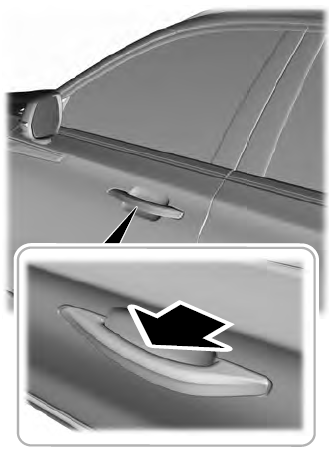Lincoln Aviator: Steering Column / Removal and Installation - Steering Column Lower Shaft
Removal
NOTE: Removal steps in this procedure may contain installation details.
-
NOTICE: Do not allow the steering column to rotate while the steering column shaft is disconnected or damage to the steering column internal sensor may result.
NOTE: Use a steering wheel holding device (such as Hunter® 28-75-1 or equivalent)
Hold the steering wheel in the straight-ahead position.
.jpg) |
-
Remove the steering column lower shaft..jpg) WARNING:
Do not reuse steering column shaft bolts. This may
result in fastener failure and steering column shaft detachment or loss
of steering control. Failure to follow this instruction may result in
serious injury to vehicle occupant(s).
WARNING:
Do not reuse steering column shaft bolts. This may
result in fastener failure and steering column shaft detachment or loss
of steering control. Failure to follow this instruction may result in
serious injury to vehicle occupant(s).
-
Remove and discard the retainer and separate the
lower steering column shaft from the upper steering column shaft.
Torque: 22 lb.ft (30 Nm)
-
Remove and discard the retainer and remove the lower steering column shaft.
Torque: 35 lb.ft (48 Nm)
-
Remove and discard the retainer and separate the
lower steering column shaft from the upper steering column shaft.
.jpg) |
Installation
-
To install, reverse the removal procedure.
 Removal and Installation - Steering Column
Removal and Installation - Steering Column
Removal
NOTICE:
To prevent damage to the clockspring, make sure the front wheels are in the straight-ahead position.
NOTICE:
Precise tolerances are required when manufacturing a
steering column...
 Removal and Installation - Steering Column Opening Seal
Removal and Installation - Steering Column Opening Seal
Removal
NOTE:
Removal steps in this procedure may contain installation details.
Remove the steering column upper shaft.
Refer to: Steering Column Upper Shaft (211-04 Steering Column, Removal and Installation)...
Other information:
Lincoln Aviator 2020-2025 Owners Manual: Autolock (If Equipped)
Autolock locks all the doors when: All doors are closed. The ignition is on. You shift into any gear putting your vehicle in motion. Your vehicle reaches a speed greater than 12 mph (20 km/h). Autolock repeats when: You open then close any door while the ignition is on and your vehicle speed is 9 mph (15 km/h) or lower...
Lincoln Aviator 2020-2025 Service Manual: Diagnosis and Testing - Diagnosis By Symptom
Symptom Chart: Automatic Transmission Diagnostics in this manual assume a certain skill level and knowledge of Ford-specific diagnostic practices. REFER to: Diagnostic Methods (100-00 General Information, Description and Operation). In most circumstances the PCM/ TCM sets a DTC to help guide with diagnostics...
Categories
- Manuals Home
- Lincoln Aviator Owners Manual
- Lincoln Aviator Service Manual
- Interior Lamps
- USB Port and Power Point Locations
- Drive Modes
- New on site
- Most important about car
Activating Intelligent Access
The intelligent access key must be within 3 ft (1 m) of the door or luggage compartment you intend to lock or unlock.
At a Door
Electronic door handles are on each door. Gently depress the switch inside the exterior door handle to unlock and open the door. An unlock symbol illuminates on the door window trim indicating your vehicle is unlocked.

